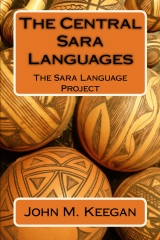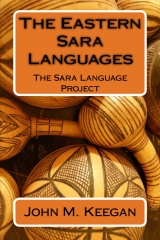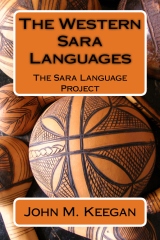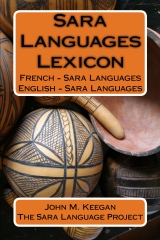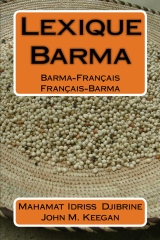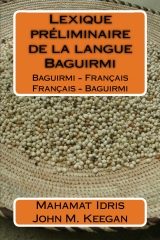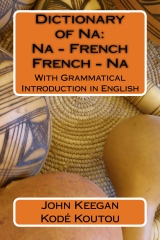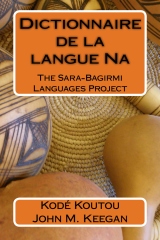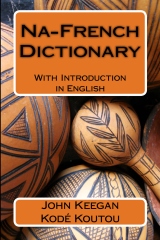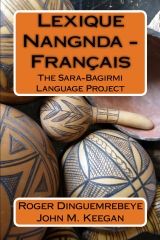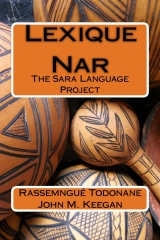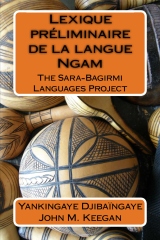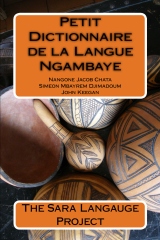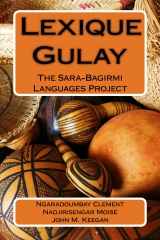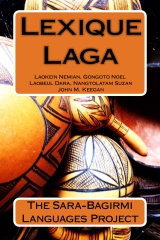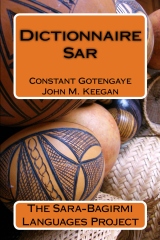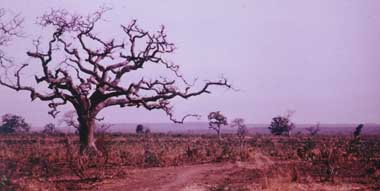
The Sara Bagirmi Languages Project
John M. Keegan
bongobagirmiorg
@gmail.com
Project Scope
This project is dedicated to the study of the Sara-Bagirmi languages, a group of the Central Sudanic branch of the Nilo-Saharan languages. They are spoken principally in Chad and northern Central African Republic. A outline of current information about the languages' geographical location, distribution, numbers of speakers, and classification can be found with SIL's Ethnologue. It is often difficult to find all the sources for these languages, and one is constantly coming across unpublished works -- student theses, missionary works, etc -- for which it is difficult to find a published reference.
All languages will be additionally identified by their Ethnologue tag, indicated by square brackets. For example, the Bagirmi language is tagged as [bmi].
Sources
Sources for the language data for specific languages is noted with that language. Most of the information regarding number of speakers and their geographic location has been taken from Lewis (2009),which we will refer to here as the Ethnologue. Another important source of data is the College Charles Lwanga in Sarh, which we refer to as CCL.
At present, the project bibliography is preliminary. We have hopes to be able to revise this in the near future. At some point we would also like to a brief summary of the works contained in the bibliography.
Project Goals
- Gathering existing language data for each of these languages (lexicons, grammatical notes, texts, conversation books, etc.) into the project database.
- Working with a control list, collect from native speakers a minimum of 700 words for each language, each with a sample sentence.
- Record words and sentences with a native speaker, and add the recordings to the language database.
- If possible, use a single system of transcription and a single font for all of the languages. A description of the writing system used for the Sara Languages is contained in Transcription for Sara Languages. The transcription for the Sara Kaba and Bagirmi languages will be similar, although there will be some letters (e.g. nasalized vowels) that are not required. Several new letters will also be needed (e.g. the palatal implosive in Kulfa and Bagirmi and the palatal nasal in Bagirmi and Sara Kaba languages)..
- As work progresses, create lexicons (in pdf format) and allow web researchers access to them from this site.
- Edit and print low-cost lexicons for distribution to language groups in Chad. Further, collections of lexicons will be into volumes that also include an introduction to the language, as well as an introduction to the subgroup and the language family. (We have currently completed 3 of these volumes: The Central Sara Languages, The Eastern Sara Languages, and The Western Sara Languages).
- Maintain and publish a comparative listing of all the project languages, with access from both French and English. (The first version of this is now complete for the Sara Languages.)
- Gather a digital version of the language data, including sound files, so that it can be distributed on DVD's with software that allows a dictionary view of the language in which users can click on words and sentences to hear them spoken by native speakers.
- To create this web site which we hope to move at some point to a university server from which all of the language data will be stored, thereby providing long-term security for the data and access to it for any interested parties. The website will all include all published works as .pdf files.
- Once the website is created, create a web application that permits simple searching of the data for any language based on the French or English word. The word, meanings, sample sentences and expressions will then be returned to the user, together with the sound files, so that the information is accessible from the internet.
Comments
- Language vs. dialects: linguists at times appear to be in a rush to make a determination as to whether a given speech form is a full-fledged languages or a mere dialect of another language or dialect group. If one were to use the most common 1,000 words as criteria for such decisions, then we would be forced to conclude that all Sara Languages are a dialect group of one language. However, when we undertake a comparison of larger dictionaries, such as the dictionary of Sar and that of Mbay, we find that less than 50% of the words are cognates. While progress is being made in this area, there are still relatively few languags for which we have more than 1,500 distinct entries. A second problem is the fact that over the past twenty years there has been an important trend of language merging. In major cities, for example, more precise vocabulary is being dropped in favor of simpler forms recognized by speakers of other languages or dialects. A major goal of this project is to create larger lexicons and dictionaries of these languages, so that speakers have the resources to relearn lost aspects of their language. The approach taken in this project is to consider all speech forms a language until we have sufficient data to prove otherwise.
- Writing System vs. Transcription: the system of transcription used in the project is not intended to be a proposal for a writing system. Rather, it is intended to capture all phonogical distinctions found in each language using a single symbol for each phoneme, with the tone clearly marked.
- Translation language: the web pages and most of the introductions to the language lexicons have been written in English. The lexicons, with the exception of Mbay, have French translations for the Sara-Bagirmi words and sentences. With the Mbay dictionary, the translations are in English.
Additional resources
Project data, both language tables and sound files may be downloaded and accessed here.
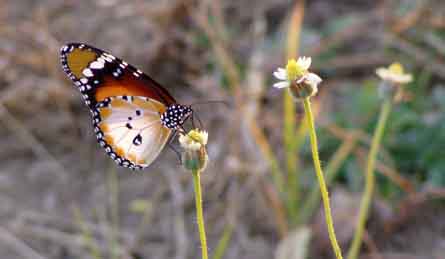
The Sara Languages
A group of some 18 languages and dialects spoken in a wide area in southern Chad and in the northern portions of the Central African Republic. The Sara Languages include Daba, Gor, Gulay, Horo (now extinct), Kaba, Laka, Mango, Murum, Mbay, Nangnda (which includes Bebote, Bejonde, Maguer, Pen and Yom), Nar, Ngam, Ngambay and Sar.
The Sara Languages Lexicons
The Sara Languages Lexicon provides access to words in the project languages from both English and French. There are approximately 1050 words included. The project languages include thirteen of the Sara languages/dialects (Bebote, Daba, Gor, Gulay, Kaba, Laga, Mango, Mbay, Nangnda, Nar, Ngam, Ngambay and Sar) and two Sara Kaba language, Na and 190 words for Kulfa.
To purchase the work click here, or view the most current version of the PDF.
Please go to the publications section of the page for a complete list of items for sale.
Central Sara as a Subgroup of the Sara Languages
There are a fair number of characteristics which appear to justify the separation of Bebote, Bejondo, Gor, Gulay and Mango as a subgroup of Sara. A few differences are listed below:
- Phonological Characteristics
- common use of the vowel pattern /o...e/.
- use of 'p' (e.g. pòr 'fire') where 'h' is found in Eastern Sara.
- maintenance of final 'r' where it becomes 'd' in Western Sara.
- Voiceless stops in intervocalic position do not become voiced as they do in Western Sara.
- Morphologial Characteristics
- use of the a verb subject plural affix not found in Eastern Sara.
- use of a noun formation prefix not found in Eastern Sara.
- use of a third person singular oblique marker not found in Eastern Sara.
- use of the a noun plural marker not found in Western Sara (Mango excepted).
- Lexical Characteristics
- use of the word njà 'foot', different from the word in Western Sara.
- use of unique form for the conditional 'if' that is not found in Eastern or Western Sara.
- the number 10 is different from the forms used in Eastern Sara.
- all use the same preposition of ownership, a form not found in Eastern Sara.
- use of a unique form for the conjuction 'and, but' (with the exception of Gulay).
Bebote
Bebote is a small Central Sara language spoken in an area around the town of Beboto, to the south of Doba and a short distance to the west of the Gor capital, Bodo. In the Ethnologue Bebote is considered a dialect of Bejondo.
Bejondo
Bejondo ([bjv]) is referred to in Ethnologue as Bejond. It is spoken in the Mandoul Occidental Department in an area around the town of Bediondo, southeast of Doba and north of the Gor capital, Bodo. According to Caprile and Fedry (1969), there were 36,000 speakers at that time.
Gor
Gor ([gqr]) is spoken in a small area south of Bedjiondo in the Doba prefecture, centered around the town of Bodo. Lewis (2009) estimates the number of speakers at 87,000.
Gulay
Gulay ([gvl]) is spoken in the Dobo, Mahim-Toki, Murum-Guley, Ngangara and Peni cantons in the Mandoul Oriental department of the Moyen-Chari, in the Murum-Guley and Kututu cantons in the department of Pende of the Logone Orientale, and in the Dono-Manga canton in the Tandjile-Est department. According to the 2009 census, there are 250,000 Gulay speakers in these three departments. This number includes some 25,000 Pen, who do not consider themselves Gulay.
Mango
Mango ([mge]), also called Mongo, Mbay Doba and Doba, is the language spoken in a wide area around the city of Doba, as well as in a few isolated villages along the Central African border. There were said to be approximately 52,000 speakers of Mango in 2006.
The Central Sara Languages Volume
The Central Sara Languages (6th edition, 495 pages), provides lexicons for four Central Sara Languages/dialects: Bebote, Gor, Gulay and Mango. Currently, the lexicon for Bejondo is not included.
Each lexicon contains between 1,150 and 1,650 words, most with samples sentences illustrating the word's use. The words and sentences have been translated into French so as to be of greater use to readers in Chad. Several hundred idioms, most with sample sentences, have also been added for Mango and Gulay.
Introductory notes in English are provided for each language, describing key features of the phonology and morphology. Also included is a more general introduction to the Sara Languages, together with a description of the transcription used in describing them. There is also a discussion of the distinctive characteristics of Central Sara which might justify its its separation as a subgroup of Sara.
To purchase the work click here, or view the most current version of the PDF.
Eastern Sara as a Subgroup of the Sara Languages
There are a fair number of characteristics which appear to justify the separation of Daba, Mbay, Nar, Ngam, and Sar into a subgroup of Sara. A few differences are listed below:
- Phonological Characteristics
- unlike Central and Western languages, all the Eastern Sara languages except for Daba maintain a phonological distinction on the basis of vowel length.
- in the Eastern Sara languages, 'h' is moderately common in initial position (e.g. hòr 'fire'). In the Cental and Western languages, these words normally appear with 'p'.
- maintenance of final 'r' where it becomes 'd' in Western Sara.
- Voiceless stops in intervocalic position do not become voiced as they do in Western Sara.
- unlike Central and Western Sara languages, schwa is not a phoneme.
- Morphologial Characteristics
- Only in Eastern Sara languages (Sar, Nar and Ngam) is -n (low tone) used as the 3rd person singular oblique pronominal suffix where reference to the subject is not required.
- use of a noun formation prefix not found in Central or Western Sara.
- use of the a noun plural marker not found in Western Sara.
- the Eastern Sara languages do not use the affix -i (in mid tone) to indicate that the subject of a very. Instead, -n (in mid tone) is normally used.
- Lexical Characteristics
- use of the word gé 'to want', a form not found in Western Sara.
- all Eastern Sara languages use the same word for 'thing', a form not used in Western Sara.
- use of the word njà 'foot', a form not found in Western Sara.
Daba
Daba ([dgk]), referred in The Ethnologue as Dagba, is said to be spoken by 40,000 speakers, principally in the Batangafo, Kabo, and Bossangoa subprefectures in northern Central African Republic, but also with a few villages on the west bank of the Bar Sarh river in the Moissala Subprefecture of Chad.
Mbay
Mbay ([myb]) is spoken by some 80,000 speakers in Chad a wide area around Moissala in the Mandul prefecture, south of Koumra. Mbay extends across the border with the Central African Republic, where another 8,300 speakers are found.
Nar
Nar is considered by the Ethnologue to be a dialect of Sar with some 32,000 speakers. It is spoken in the area around Beboro, between Koumra and Sar.
Ngam
Ngam ([nmc]) is spoken in a wide area around Maro, south of Sarh, and spreading south across the border with the Central African Republic. According to the 1993 census, there were some 43,000 speakers in Chad and another 18,000 in Central Africa. The Ethnologue also reports that speakers of the extinct language Horo now speak a dialect of Ngam.
Sar
According to the Ethnologue, Sar ([bjv]) is spoken by approximately 151,000 speakers (subtracting the 32,000 speakers of Nar). It is spoken in a wide area around Sarh, Bedaya and Koumra in the Moyen-Chari and Mandul prefectures in southern Chad.
The Eastern Sara Languages Volume
The Eastern Sara Languages (5th edition, 443 pages), provides lexicons for four Eastern Sara Languages/dialects: Daba, Nar, Ngam and Sar. Currently, a lexicon for Mbay is not included.
Each lexicon contains between 900 and 1,450 words, most with samples sentences illustrating the word's use. The words and sentences have been translated into French so as to be of greater use to readers in Chad. Several hundred idioms, most with sample sentences, have also been added for Sar and Nar.
Introductory notes in English are provided for each language, describing key features of the phonology and morphology. Also included is a more general introduction to the Sara Languages, together with a description of the transcription used in describing them. There is also a discussion of the distinctive characteristics of Eastern Sara which might justify its its separation as a subgroup of Sara.
To purchase the work click here, or view the most current version of the PDF.
Western Sara as a Subgroup of the Sara Languages
There are a fair number of characteristics which appear to justify the separation of Kaba, Laka and Ngambay into a western subgroup of Sara. A few differences are listed below:
- Phonological Characteristics
- when 'd' is immediately followed by a word-final barred-i in Central and Eastern languages, it appears as 'r' in the western Sara Languages.
- when 'h' appears in the Eastern Sara languages, 'p' appears in Western Sara (e.g. pòr 'fire').
- When voiceless stops appear in intervocalic position in Eastern and Central Sara languages, they are voiced in Western Sara.
- Morphologial Characteristics
- Only the Western Sara languages use with je (mid-tone) with the oblique pronominal markers to indicate respect.
- The Western Sara languages employ the prefix n- (in high tone) to indicate 'he, she' before verbs. In Eastern Sara and most Central Sara languages, 'he, she' is indicated by the lack of an prefix.
- The Western Sara languages mark the plural of nouns je (in mid tone). Eastern Sara languages and most Central Sara languages use a different plural marker.
- Only in the Western Sara languages Laka and Ngambay is no distinction made between 'our' and 'your (plural)'.
- Lexical Characteristics
- The word in Western Sara for 'foot' is distinct than that used in Eastern and Central Sara languages.
- The word in Western Sara for 'six' is distinct than that used in Eastern and Central Sara languages.
- The Western Sara word for 'stomach' is different from the word used in Eastern Sara.
- The Western Sara word for 'many, much; very' is distinct from the word used in Eastern Sara and most Centra Sara languages.
Kaba
Kaba ([ksp]) is called "Kabba" in numerous works, as in some dialects the 'b' is implosive. According to the Ethnologue, there are 72,000 speakers in the Paoua and Marounda subprefectures of northern Central African Republic, and 11,000 speakers in Chad in the area around Gore, to the south of Moundou.
Laga
According to the Ethnologue,Laga ([lap]) is spoken by approximately 55,000 people. The Laga are found in southern Chad, principally in the Bessao, Monts de Lam and Oudoumia cantons to the south of Moundou. In addition, there are some 2,000 speakers in northern Central African Republic in the Bocaranga Subprefecture. L'Association de Recherche et d'etudes de la Langue Laga claims that there are also many thousands of speakers living in Cameroon.
Murum
The Ethnologue considers Murum a dialect of Ngambay. Negor and Mekongoto (1978) consider Murum a distinct language, spoken the Gabri Ngolo, Dormo and Murum-tulum cantons which lie north of the city Doba and west of the Gulay speaking cantons.
Ngambay
Ngambay ([sba]), with around a million speakers, is by far the largest Sara language, and it probably has the largest number of native speakers of any language in Chad. It is spoken in a wide area around the city of Moundou in southern Chad and throughout the Sara neighborhoods of N'djamena.
The Western Sara Languages Volume
The Western Sara Languages (2nd edition, 457 pages), provides lexicons for three Western Sara Languages/dialects: Kaba, Laka and Ngambay. Currently, information for Murum is not included.
The lexicon for Kaba contains approximately 1025 words, the lexicon for Laka has 1875 words, and the lexicon for Ngambay has over 3,000 words and over 900 idioms. Samples sentences are included for most words. The words and sentences have been translated into French so as to be of greater use to readers in Chad.
Introductory notes in English are provided for each language, describing key features of the phonology and morphology. Also included is a more general introduction to the Sara Languages, together with a description of the transcription used in describing them. There is also a discussion of the distinctive characteristics of Western Sara which might justify its its separation as a subgroup of Sara.
To purchase the work click here, or view the most current version of the PDF.
Additional Information
Sara Vowel System, Proceedings of the Sixth International Nilo-Saharan Linguistics Conference Santa Monica 1995, March 27-29
1990 Word List of Daba taken in Moissala in 1989. The dialect found here is very different from the dialect of Daba described in the Eastern Sara Languages volume.
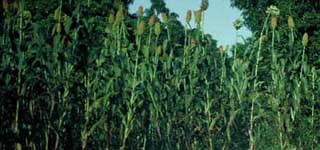
The Sara Kaba languages
The Sara Kaba languages are spoken in an area in Southern Chad generally east of the area where the Sara languages are spoken. They include five languages: Kaba Na, Kaba Deme, Kulfa, Sara Dunjo, and Sara Kaba.
In the classification of the Sara Kaba group used in the Ethnologue, it is considered a Sara Proper Language. This gives the erroneous impression that these languages are as closely related to other Sara Proper languages, say Gulay or Sar, as Gulay and Sar are to each other. While Sara Proper Languages and Sara Kaba Languages are clearly related, there are important phonological, morphological, lexical and syntactic differences. A speaker of a Sara language in N'Djamena will be able to understand much of what a speaker of any other Sara Proper dialect is saying. But he or she will be unable to understand sentences in a Sara Kaba languages such as Na. A preliminary comparison of differences between Sara Kaba and Sara Proper languages is found in at Sara Kaba Is Not Sara Proper.pdf
Deme
Deme, also called Kaba Deme or Sara Kaba Deme, is spoken in southern Chad in an area directly to the east of Sarh. According to Palayer(2006) Deme spreads 120 kilometers along the east bank of the Chari River, in the Moussafoyo, Banda, Marabe, Bohobe, Sime-Gotobe and Baltoubaye cantons, as well as in certain neighborhoods in Sarh. According to the Ethnologue, there are some 40,000 speakers in Chad, and unknown number in the Central African Republic.
Kulfa
According to the Ethnologue, there were some 7,300 speakers of Kulfa and closely related dialects in 1993, living in the Southeast part of the Moyen Chari Prefecture in the Kyabe Subprefecture, southwest of Lake Iro and centered in Alako and Kirimikoro.
Na
Na, also called Kaba Na or Sara Kaba Na, is spoken in the Moyen-Chari region, Lac Iro Department, centered in Kyabe, and in Central African Republic. The Ethnologue estimates that there were 35,000 speakers in Chad in 1993.
Sara Dunjo
According to the Ethnologue there were in 1996 approximately 4,000 speakers of Sara Dunjo, in the Ndele Subprefecture in the Central African Republic, near the Chadian border.
Sara Kaba
According to the Ethnologue there were in 1996 approximately 13,600 speakers of Sara Kaba in the Ndele and Birao Subprefectures in the Central African Republic.
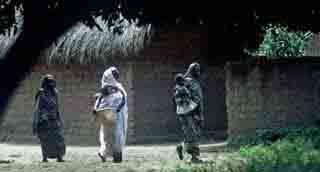
The Vale Languages
Only two languages belong to this grouping: Vale and Lutos. Both are spoken in northern Central African Republic, to the south of the Chadian town Maro.
Lutos [ndy]
According to the Ethnologue, there are some 17,000 speakers of Lutos in in the Central African Republic, in the Ndele, Kabo Andoro and Kabo Subprefectures, and some 1980 speakers in Chad in the Moyen Chari Prefecture south of the Ngam in the Grande Sido Departement.
Vale [vae]
According to the Ethnologue, there were some 5,400 Vale speakers in 1996, living in the Batangafo, Kabo and Kaga Bandoro Subprefectures of northern Central African Republic.
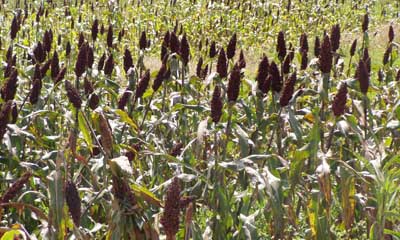
The Bagirmi Languages
A group of 8 languages spoken in a wide area in central Chad spreading from the area around Bousso to the Guera further east. These languages are: Bagirmi, Berakou, Disa, Gula, Jaya, Kenga, Morom and Naba. Of these, only Bagirmi, Kenga and Naba (formerly Kuka, Bilala and and Medogo) have more than 30,000 speakers, and most of the others are in grave danger of extinction.
Bagirmi [bmi]
Bagirmi, more commonly known as Barma inside Chad, had some 44,000 speakers in 1993. According to the Ethnologue, it is spoken in the Massenya Subprefecture, and in Bousso Subprefecture, Bousso area. Gol are at Massenya; Kibar east of Massenya; Bangri west of Massenya and along Chari River between Guelendeng and N'Djamena; along Chari River from Bousso to Guelendeng.
Berakou [bxv]
Berakou, also known as Bubalia or Babalia, had, according to the Ethnologue, had only 2 speakers in 1995, and both were over 60 years of age. The Babalia people live in approximately 23 villages in the N'djamena Subprefecture, north of Djermaya, between Karal and Tourba.
Disa [dsi]
According to the Ethnologue, there are some 2000 speakers of Disa living in the Chinguil Subprefecture in the Guera region.
Gula [glu]
According to the Ethnologue, there are some 10,000 speakers of Gula living in the Alako and Boum-Kebir subprefectures southwest of Lake Iro in the Moyen-Chari Prefecture.
Jaya [jyy]
According to the Ethnologue, there were in 1993 2,200 speakers of Jaya living in the Bitkine subprefectures of the Guera Region, 50 kms. north of Bitkine.
Kenga [kyq]
According to the Ethnologue, there were in 1997 some 40,000 speakers of Kenga living in 52 villages in the Bitkine, Bokoko and Gama subprefectures .
Morom [bdo]
According to the Ethnologue, there were in 2002 some 4,500 speakers of Morom living in Bitkine subprefectures around the town of Bitkine.
Naba [mne] (Kuka, Bilala, Medogo)
;According to the Ethnologue, there were in 2006 some 278,000 speakers of Naba, including 136,629 Bilala, 76,660 Kuka, and 19,159 Medogo. The Ethnologue adds that "Bilala, Kuka, and Medogo are 3 ethnic groups who share a common culture and speak essentially the same language, called "Naba" by all 3 groups."
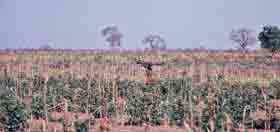
Birri and Fongoro
Birri [bvq]
A nearly extinct language spoken in northern Central African. Most dialects are extinct, and there are only an estimated 200 remaining speakers.
Fongoro [fgr]
A language spoken in Oaddai in the Fongoro prefecture along the Sudanese border. There are only an estimated 1,000 speakers.
Publications
All work is available for purchase below through createspace.com. which may be accessed by clicking the links or images below
The Central Sara Languages
John M. Keegan
April 5, 2012
A collection of lexicons for four Central Sara languages (Bebote, Gor, Gulay and Mango) spoken in southern Chad. Each lexicon contains over 1,000 words, most with sample sentences, and an introduction describing key features of the phonology and morphology of the language. The introductions are written in English, while the lexicon translations are in French in order to be more useful to readers in Chad.
This fifth edition is a major revision of this work, and the Gulay and Mango portions have been greatly expanded. There are now more than 1600 words for both of these languages, the number of sentences has been increased, and hundreds of idioms added, most with sample sentences.
The Eastern Sara Languages
John M. Keegan
April 11, 2012
This is the second of a series of volumes dedicated to the study of the Sara Languages, a group of languages and dialects spoken in Southern Chad. It includes lexicons for four of the Eastern Sara languages: Daba, Nar, Ngam and Sar. Each lexicon contains between 850 and 1350 words, most with sample sentences illustrating the word's use, and with translations in French so as to make the work more usable to readers in Chad. The work contains a general introduction to the sound system of the Sara Languages, discussion of the unique aspects of Eastern Sara, and an introduction to the each of the four languages.
The Western Sara Languages
John M. Keegan
November 13, 2012
This is the third of a series of volumes dedicated to the study of the Sara Languages, a group of languages and dialects spoken in Southern Chad. It includes lexicons for three Western Sara languages: Kaba, Laka and Ngambay. The Kaba lexicon contains over 900 words, the Laka lexicon over 1850, and the Ngambay lexicon more than 3000 words. Sample sentences illustrating the words' uses have been included for the majority of the words. The work contains a general introduction to the sound system of the Sara Languages, discussion of the unique aspects of Western Sara, and an introduction to the each of the three languages. The introductory portions are in English, the translations for the lexicons in French, in order to make the work usable to readers in Chad.
Sara Languages Lexicon
John M. Keegan
January 18, 2013
A comparative lexicon of 13 Sara-Bagirmi languages spoken in Southern Chad, organized into two sections: French -- Sara Languages, and English -- Sara Languages. Each contain approximately 1050 words, taken from work done for the Sara Language Project.
Lexique Barma: Barma - Français, Français - Barma
Mahamat Idriss Djibrine, John M. Keegan
February 24, 2016
La langue Barma, ou bien Baguirmi, appartient au groupe Sara-Baguirmiènne, qui comprend le Kenga, le Bilala, le Kuka, le Modogo, le Jana, et aussi les langues Sara Kaba et les langues Sara. Ces groupes appartiennent à la famille Nilo-Saharienne. La langue Barma est parlée dans la région de Chari-Bagirmi, au sud-est de N'djaména, et aussi une partie de la région de Guéra, du Moyen-Chari et du Tanjilé.
Ce lexique contient plus de 2430 mots, 2650 phrases illustratives et 290 expressions idiomatiques. Les informations sur la langue ont été recueillies à N'Djaména au cours des étés 2013, 2014 et 2015 en travaillant avec Mahamat Idriss. Cet ouvrage repose sur le travail de Henri Gaden, R. C. Stevenson et Goodman et al.
Lexique préliminaire de la langue Baguirmi
Mahamat Idris, John M. Keegan
May 19, 2015
Barma, ou bien Baguirmi, est une langue Sara-Bagirmiènne parlée dans la région de Chari-Bagirmi, au sud de N'djaména. Il y a plus de 48.000 locuteurs de la langue. Ce lexique contient environ 1470 mots, 1445 phrases illustratives et 150 expressions idiomatiques. Les informations sur la langue ont été recueillies à N'Djaména au cours des étés 2013 et 2014 en travaillant avec Mahamat Idris.
Bagirmi Lexicon: Bagirmi - French, French - Bagirmi
John M. Keegan, Mahamat Idriss Djibrine
February 16, 2016
Bagirmi is a Sara-Bagirmi language of the Central-Sudanic branch of Nilo-Saharan which according to Lewis, Simons, and Fennig (2015) is used by some 35,000 speakers principally in the Chari-Bagirmi region of Chad. There are also a fairly large number of speakers found in the Chadian capital, N'djamena.
This lexicon contains over 2,430 words, 2,650 sample sentences and 290 expressions and idioms. In addition, a 90 page introduction to the grammar of Bagirmi is included. The research for work was completed in N'djamena, principally during the summers of 2014 and 2015.
Dictionary of Na: Na-French, French-Na
Kodé Koutou, John M. Keegan
December 24, 2015
Na, also known as Sara Kaba Na, is a Sara Kaba language used by some 35,000 speakers in the area around Kyabé in southern Chad. There are also a large number of speakers in the Chadian capital N'djamena. The Sara Kaba languages are one of three subgroups of Sara-Bagirmi, a grouping of some 29 Central Sudanic languages of the Nilo-Saharan family.
This dictionary contains more than 3180 words, 4040 sample sentences, and 720 idiomatic expressions. The Na data was gathered in N'djamena during the summers of 2012, 2013. 2014 and 2015 working principally with Kodé Koutou. A French-Na index is now included in this work, as well as a 65 page grammatical introduction that includes a discussion of the classification of the Sara Kaba languages.
This version of the dictionary replaces previous project lexicons and dictionaries.
Na - French Lexicon
Kodé Koutou, John M. Keegan
November 19, 2013
Na, also known as Sara Kaba Na, is a Sara Kaba language used by some 35,000 speakers in the area around Kyabé in southern Chad. There are also a large number of speakers in the Chadian capital N'djamena. This lexicon contains approximately 2780 words, 2000 sample sentences, and 580 idiomatic expressions. The Na data was gathered in N'djamena during the summers of 2012 et 2013, working principally with Kodé Koutou. The work also contains a 42 page introduction explaining the basic features of the phonology, morphology and syntax of the language. This Na lexicon provides an excellent starting point for a future dictionary of this language.
Dictionnaire de la langue Na
Kodé Koutou, John M. Keegan
February 16, 2016
Na, ou Sara Kaba Na, est une langue Sara Kaba parlée au sud du Tchad dans la région de Kyabé. Selon Keegan (2014) la langue Na n'est pas une langue Sara; elle est plutôt apparentée à Démé, Kulfa, Sara Dunjo et Sara Kaba.
Ce dictionnaire contient environ 3180 mots, 4040 phrases illustratives et 720 expressions idiomatiques. Les informations sur la langue Na ont été recueillies à N'Djaména au cours des étés 2012, 2013 et 2014 en travaillant principalement avec Kodé Koutou. Cet ouvrage repose sur le Dictionnaire Sara-Kaba-Na - Français, (Danay et al [1986]), publié au Collège Charles Lwanga à Sarh.
Na - French Dictionary
Kodé Koutou, John M. Keegan
November 24, 2014
Na, also known as Sara Kaba Na, is a Sara Kaba language used by some 35,000 speakers in the area around Kyabé in southern Chad. There are also a large number of speakers in the Chadian capital N'djamena. The Sara Kaba languages are one of three subgroups of Sara-Bagirmi, a grouping of some 29 Central Sudanic languages of the Nilo-Saharan family.
This brief dictionary contains more than 3050 words, 3150 sample sentences, and 700 idiomatic expressions. It also contains a 60 page introduction explaining the transcription used, pronunciation, and basic elements of the grammar.
The Na data was gathered in N'djamena during the summers of 2012, 2013 and 2014, working principally with Kodé Koutou. The work is based on the "Dictionnaire Sara-Kaba-Na - Français" published at the Collège Charles Lwanga in Sarh.
Lexique Nangnda - Français
Roger Dinguemrebeye, John M. Keegan
January 16, 2014
La langue Nangnda est une langue Sara parlée au Sud du Tchad dans le Département du Mandoul Occidental, Région du Mandoul, et dans le Département de Kouh-Ouest, Région du Logone Oriental. Elle est aussi parlée dans la Sous-préfecture de Bédjo à Kouh-Est et dans certains villages de la Sous-préfecture de Béti. Les langues Sara sont du sous-groupe Sara-Baguirmienne de la famille Nilo-Saharienne. Ce lexique contient plus de 2700 mots avec plus de 1300 phrases examplaires.
Lexique Nar
Rassemngué Todonane, John M. Keegan
May 7, 2012
A short lexicon of the Nar language, a Central-Sudanic language spoken in southern Chad.
Lexique préliminaire de la langue Ngam
Yankingaye Djibaïngaye, John M. Keegan
June 22, 2016
Ngam est une langue Sara parlée au sud du Tchad dans la région de Mandoul. La langue Ngam est apparentée aux langues Saras Orientales: Mbay, Nar, Sar et Daba. Il y avait a peu près 61,400 locuteurs de Nar en 1993.
Ce lexique préliminaire contient environ 740 mots, 660 phrases illustratives et 100 expressions idiomatiques. Les informations sur la langue
Nar ont été recueillies à N'Djaména au cours de l'été 2015. Le lexique doit être consideré un point de départ pour futur travail avec cette langue interessante.
Petit Dictionnaire de la Langue Ngambaye
Nangone Jacob Chata, Simeon Mbayrem Djimadoum, John M. Keegan
May 12, 2012
Dictionnaire préliminaire de Ngambay, langue Sara parlé au sud du Tchad dans la région de Moudou. Le travail contient plus de 3.000 mots et 3.100 phrases illustratives.
Lexique Gulay
Ngaradoumbay Clement, Nadjirisengar Moise, John M. Keegan
May 7, 2012
Gulay est une langue parlée au sud du Tchad dans la préfecture de Dono Manga, au Nord-est de Doba. Sélon Keegan (2012) Gulay est plus apparantée aux langues Saras Centrales (Gor, Bedjondo, et Mango) qu'aux langues Saras de l'Est (Sar, Mbay, Ngam, etc.). Selon Lewis (2009), il y avait environ 163.000 locuteurs de Gulay en 1993. Gulay appartient au groupe Sara, de la famille nilo-saharienne (groupe soudanais central et sous-groupe bongo-baguirmienne). Ce lexique contient à peu près 1650 mots, 1850 phrases illustratives et 240 expressions idiomatiques. L'information sur Gulay a été recueillie à N'Djaména au cours des étés 2010, 2011, et 2012, en travaillaint surtout avec Ngaradoumbay Clement. On a aussi travaillé une session longue avec Nadjirisengar Moise. Le lexique doit être consideré un point de départ pour un dictionnaire authentique de cette langue intéressante. Nous avons l'espoir de pouvoir effectuer un petit dictionnaire avec plus de 3000 mots avant la fin de 2013.
Lexique Laga
Laokein Nemian, Noel Gongoto, Laobeul Dara, Suzan Nangtolatam, John M. Keegan
January 16, 2014
Ce lexique de Laga contient plus de 2200 mots, 1980 phrases illustratives et 150 expressions idiomatiques. Les informations sur la langue ont été recueillies à N'Djaména au cours des étés 2011, 2012, 2013, 2014 et 2015 en travaillant avec Laokein Nemian, Gongoto Noel, Laobeul Dara et Nangtolatam Suzan. Nous avons l'espoir d'effectuer dans l'avenir un vrai dictionnaire de cette langue intéressante.
Dictionnaire Sar
Constant Gotengaye, John M. Keegan
March 7, 2016
Sar est une langue Sara, un groupe de langues Sara-Baguirmiènnes de la famille Nilo-Sahariènne. Sar est parlée au sud du Tchad dans les régions de Moyen-Chari et Mandoul. La langue Sar est apparentée aux langues Saras Orientales: le Mbay, le Ngam, le Nar et le Daba. Il y avait à peu près 183,000 locuteurs de Sar en 1993.
Ce dictionnaire contient plus de 3050 mots, 3850 phrases illustratives, 350 expressions idiomatiques et 80 illustrations. Les informations sur la langue Sar ont été recueillies à N'Djaména au cours des étés 2010, 2011, 2012, 2013, 2014 et 2015 en travaillant avec Gotengaye Constant. Cet ouvrage repose sur le travail du Collège Charles Lwanga à Sarh.
